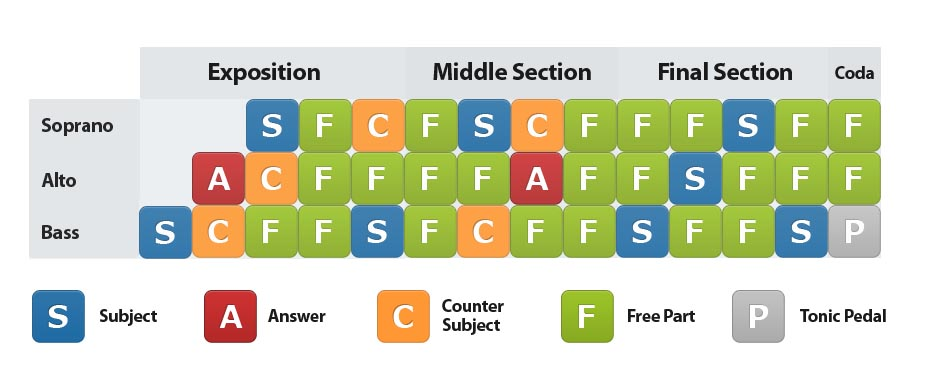Structure in Music and the Fugue
By Carl and Jack
Music is the voice that floats freely over the world wherever it pleases. But even those that are free are never truly free. Music must follow the structure of its origin or culture performed in. In western music, we tend to stick to the hard classics of the Binary form, Ternary form and Sonata form. We will dive into just a few structures and the fugue structure and the complexity behind it.
One of the most basic melody forms in music of many cultures is the binary form. A song that is Binary has two different melodies that usually contrast each other in and are the same length are usually repeated. These melodies are typically labeled as section A and Section B. This form is known as a simple binary structure. There are also many other different variations on the binary form. The Binary form itself is a very loose category which allow for many different variations of the structure. Some of these variations include rounded binary. The rounded binary form is similar to the simple binary but at the end of the B melody the piece returns to the main melody and then finishes instead of ending at the B melody. 

Another common structure that is found in music all around the world is the Ternary structure. Ternary Structure is similar to the binary structure except that there are three sections instead of two sections. Just like Binary forms, there are many different variations on the ternary form. One of these examples is the Compound ternary form. Compound ternary is when the A and B sections are are split into either binary or ternary subsections within the piece. The American song form are both examples of ternary forms. The american song form is a 32 bars and is commonly used in Jazz standards long and is split up and put into AABA. An example of the AABA is Duke Ellington’s Don’t Get Around Much Anymore.
Music is full of traditions and different styles of music, but the fugue stand out from all other traditions. The one detail about the fugue that makes it stand out is the complex structure that the fugue weaves between different voices and instruments. Fugues usually follow the sonata form and contain three main sections. In the sonata form, the three sections are the exposition, development and with recapitulation with an optional coda. Within each section, there are different elements that happen and that are arranged differently.
In the exposition, it starts off with the main subject leading the piece until the original voice is joined by a second voice. The first voice continues into a counter subject while the new voice is the answer to the original subject being a fifth higher in pitch. Then to make it all the more confusing, the subject returns in a new third voice usually an octave higher or lower with the second voice giving a counter melody to the new melody, with the original voice now in a free part, floating along with the other two voices. Here is a great example of the process of exposition: https://youtu.be/U7QMATFjdSw
As the piece continues into the middle section or the development, each voice trades off between either playing a free part, picking up the original subject, or playing the answer or counter-part along with it. In the final section or the recapitulation, only free parts and the original subject is passed around to make a smooth flow to the end with the coda using a tonic usually in the bass voice and the other voices floating above till the last chord.
A great example of a fugue is Bach’s little fugue :https://youtu.be/ddbxFi3-UO4
The fugue is one of the most complex forms to follow when writing music as it can become confusing to compose. But with all these structures that were made to help us write music, but we first have to create the idea. Music is not entirely free, but it can help us become free and liberated.
Bibliography:
"BINARY AND TERNARY FORMS." BINARY AND TERNARY FORMS (n.d.): n. pag. Web. 11 Oct. 2015. <http://myweb.fsu.edu/nrogers/Handouts/Binary_Ternary_Form_Handout.pdf>.
"Musical Form." Wikipedia. Wikimedia Foundation, n.d. Web. 12 Oct. 2015. <https://en.wikipedia.org/wiki/Musical_form>.
"Ternany Form." Wikipedia. Wikimedia Foundation, n.d. Web. 11 Oct. 2015. <https://en.wikipedia.org/wiki/Ternary_form>.
Ziegler, Robert. "The Baroque Spirit: Counterpoint and Fugue." Music: The Definitive Visual History. N.p.: n.p., 2013. 100-01. Print.
Work:
Carl: Fugue, pictures and fugue music
Jack: Binary and ternary form
No comments:
Post a Comment